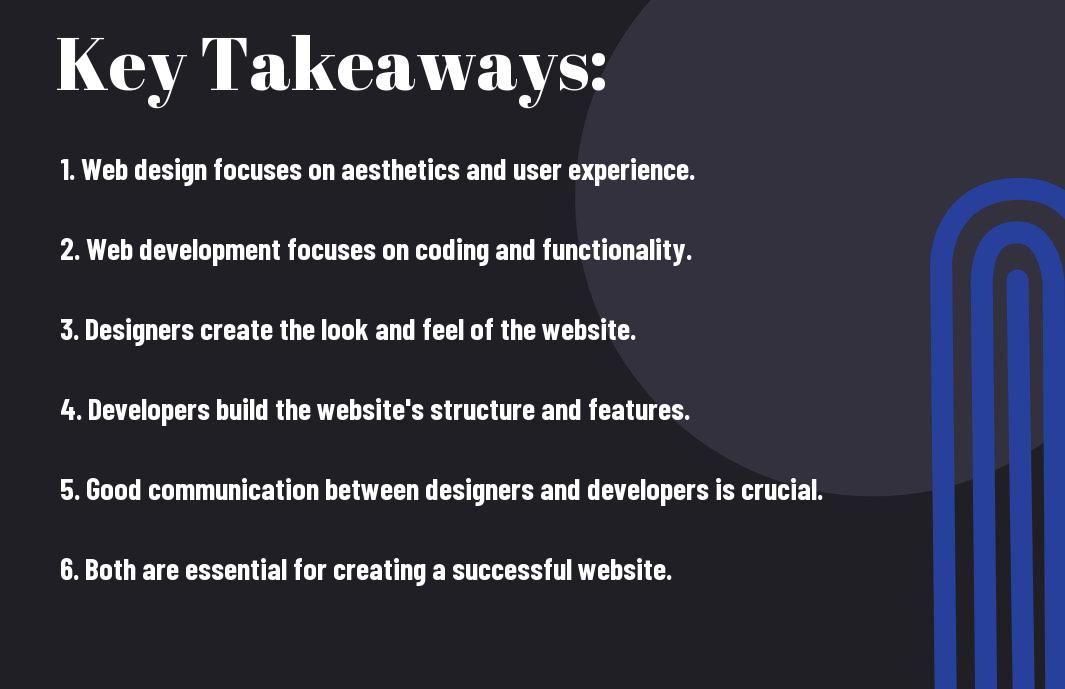Do you struggle to understand the difference between web design and web development? You’re not alone. Many people use the terms interchangeably, but they actually refer to two distinct aspects of creating a website. Web design focuses on the visual and user experience aspects of a website, including layout, colors, and fonts, while web development deals with the technical aspects of building a website, such as coding and creating functionality. It’s important to understand these differences, as they play a crucial role in creating a successful website. In this blog post, I will break down the key disparities between web design and web development, so you can gain a clearer understanding of each discipline and how they contribute to the overall success of your website.
Key Takeaways:
- Web design focuses on the aesthetics and user experience of a website, while web development deals with the technical aspects and functionality.
- Understanding the difference between the two disciplines is crucial for businesses looking to create a successful online presence.
- Web designers are responsible for creating visually appealing layouts, while web developers work on coding and implementing features.
- Both roles are essential for creating a well-rounded website, and collaboration between the two is key to a successful project.
- Recognizing the unique skill sets and expertise of web designers and web developers can lead to a more efficient and effective web development process.


Web Design: Crafting the Visual Experience
Even if you’re not a web designer yourself, you interact with web design every day. Every time you visit a website, you experience the work of a web designer. Web design is all about crafting the visual aspects of a website, including layout, color scheme, typography, and imagery. It’s the process of creating an aesthetically pleasing and user-friendly experience for website visitors.
Principles of Web Design
When it comes to web design, there are several key principles that guide the creation of effective and engaging websites. These principles include balance, contrast, emphasis, and unity. Balance ensures that the elements on the page are distributed evenly, while contrast helps certain elements stand out. Emphasis directs the user’s attention to the most important parts of the page, and unity ensures that all elements work together cohesively. By understanding and applying these principles, you can create visually appealing websites that effectively communicate your message and engage your audience.
Tools and Technologies for Designers
As a web designer, it’s important to have a good understanding of the tools and technologies available to help you bring your design ideas to life. From graphic design software like Adobe Photoshop and Illustrator to web design platforms like Sketch and Figma, there are a variety of tools that can help you create visually stunning websites. Additionally, having a strong understanding of HTML, CSS, and JavaScript allows you to bring your designs to life on the web. These technologies give you the power to create interactive and dynamic web experiences that captivate your audience.
Understanding the principles of web design and the tools and technologies available to designers is crucial in crafting visually compelling and user-friendly websites. By mastering these aspects of web design, you can create impactful online experiences that effectively communicate your message and engage your audience.
Web Development: Bringing Functionality to Life
Despite the similar-sounding names, web development is a completely different field from web design. While web design focuses on the visual and user experience aspects of a website, web development brings functionality to life. If you want to understand the difference between a web designer and web developer in more detail, you can check this article on Difference between Web Designer and Web Developer.
Front-End Development
Front-end development involves building the parts of a website that users interact with directly. This includes the layout, navigation, buttons, and interactive elements. As a front-end developer, you are responsible for creating a seamless user experience that not only looks great but also functions perfectly. You’ll write code using languages like HTML, CSS, and JavaScript to bring the web design to life in a way that engages and captivates your audience.
Back-End Development
On the other hand, back-end development involves the part of a website that users don’t see but is crucial for the site’s functionality. This includes the server, database, and application logic. As a back-end developer, you are the architect and engine behind the scenes, ensuring everything runs smoothly and efficiently. You’ll work with technologies like PHP, Ruby on Rails, or Node.js to handle complex operations and ensure that the website functions flawlessly.
Collaboration Between Design and Development
Keep in mind that collaboration between web design and web development is essential for a successful project. The design team is responsible for creating the visual aspects of the website, while the development team is in charge of bringing the design to life through coding and programming. In order to produce a high-quality website, it’s crucial for the design and development teams to work together seamlessly.
Communication and Workflow Strategies
Effective communication between the design and development teams is key to ensuring a smooth workflow. This can be achieved through regular meetings and updates, as well as the use of project management tools to track progress and assign tasks. By establishing clear channels of communication and workflow strategies, you can prevent potential conflicts and ensure that the project stays on track.
Integrated Project Examples
Integrated project examples, where the design and development teams work closely together from the beginning, can result in cohesive and visually appealing websites. By having both teams involved in the planning and execution of the project, you can ensure that the design is not only visually stunning but also functional and user-friendly. When design and development are seamlessly integrated, the end result is a website that truly stands out and meets the needs of the users.
Career Paths and Education
After understanding the key differences between web design and web development, you may be wondering about the career paths and education required for each profession. If you want to delve deeper into this topic, you can check out the article on Web Design vs. Web Development: What’s the Difference?
Becoming a Web Designer
If you are interested in becoming a web designer, you will need to have a keen eye for visual aesthetics and understand the principles of design. Pursuing a degree in graphic design, web design, or a related field can be beneficial. Additionally, gaining experience with design software and keeping up with current design trends will be crucial for your success in this field. As a web designer, you will be responsible for creating the look and feel of a website, optimizing user experience, and ensuring that the design is visually appealing and functional.
Becoming a Web Developer
If you are more inclined towards the technical aspects of building websites, pursuing a career as a web developer may be the right choice for you. To become a web developer, you will need to acquire strong programming skills and have a good understanding of web development technologies such as HTML, CSS, and JavaScript. Pursuing a degree in computer science, software engineering, or a related field can provide you with the necessary skills and knowledge. As a web developer, you will be responsible for the coding and programming that brings a website design to life, ensuring its functionality and performance.
By choosing a career as a web designer or web developer, you can leverage your strengths and interests to carve out a successful career path. Keep in mind that both professions offer unique challenges and opportunities, and with the right education and skills, you can excel in either field. Remember, the demand for skilled web designers and web developers continues to grow, presenting exciting prospects for those entering the industry.
Conclusion
Hence, it is important for you to understand the difference between web design and web development in order to effectively communicate your needs and expectations to the professionals you are working with. By knowing the distinctions between design and development, you can better convey your vision and goals for your website, ensuring that the end result aligns with your desires. Additionally, having a clear understanding of these roles will aid in the efficiency and success of your web project, as you will be able to effectively collaborate with the designers and developers to bring your vision to life.
Understanding the Difference between Web Design and Web Development
Q: What is web design?
A: Web design refers to the aesthetic and functional aspects of a website, including layout, color scheme, typography, and user experience (UX) design. It focuses on creating an attractive and user-friendly interface for the website.
Q: What is web development?
A: Web development involves the technical aspects of building a website, such as programming, database management, server configuration, and other backend processes. It is responsible for bringing the design to life and ensuring the website functions as intended.
Q: What are the key differences between web design and web development?
A: The main difference lies in their focus – web design is primarily concerned with the visual appearance and user experience of the website, while web development focuses on building and maintaining the technical infrastructure of the site. Designers work on the front end, while developers work on the back end.
Q: Do web designers and web developers work together?
A: Yes, web designers and web developers often collaborate closely to create a cohesive and effective website. Designers provide the visual concepts and user interface designs, which developers then bring to life through coding and programming. This partnership is essential for a successful website project.
Q: What skills are required for web design and web development?
A: Web designers need proficiency in graphic design software, an understanding of UX principles, and knowledge of front-end technologies such as HTML, CSS, and JavaScript. Web developers need expertise in programming languages like Java, Python, or PHP, as well as database management and server-side scripting. Both roles require creativity, problem-solving abilities, and a good understanding of web design principles.
